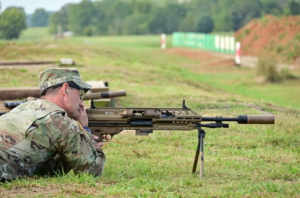The Army has officially equipped its first unit with the Next-Generation Squad Weapons (NGSW) and new 6.8 caliber ammunition, the service said on Thursday.
A brigade from the 101st Airborne Division at Fort Campbell is the first unit to receive the new Sig Sauer-produced NGSW Rifle and Automatic Rifle, the Army said.

“The NGSW fielding is a culmination of a comprehensive and rigorous process of design, testing and feedback, all of which were led by soldiers,” Col. Jason Bohannon, project manager for soldier lethality, said in a statement. “As a result, the Army is delivering on its promise to deliver to Soldiers the highest quality, most capable small-caliber weapons and ammunition.”
Sig Sauer won the Army’s potential 10-year, $4.7 billion NGSW contract in April 2022 to deliver the new XM7 Rifle and the XM250 Automatic Rifle that will fire 6.8 caliber bullets, as the Army looks to replace the M4 rifles and M249 Squad Automatic Weapon for its close combat forces (Defense Daily, April 19 2022).
The soldiers from the 1st Battalion, 506th Infantry Regiment assigned to the 101st Airborne Division first received the NGSW rifles and automatic rifles for new equipment training last April.
The Army said that it’s planning to field NGSW weapons and ammunition to a National Guard armored brigade in May.
Army officials said recently the service has tested the NGSW capabilities in extreme cold weather, allowing soldiers at the Cold Regions Test Center in Fort Greely, Alaska to assess the weapons’ performance in temperatures that dipped to 35 degrees below zero (Defense Daily, March 1).
“Extreme cold can affect the weapon’s functionality, of course, but it also hinders a soldier’s movement and mobility,” Maj. Brandon Davis, a member of the Army’s Soldier Lethality Cross Functional Team, said in a statement. “So which sling does he prefer in these conditions? Can he or she effectively manipulate the widgets on the weapon wearing gloves? We’re getting after every aspect of how the NGSW impacts lethality and mobility under extreme conditions.”